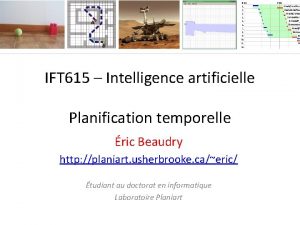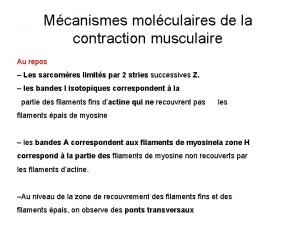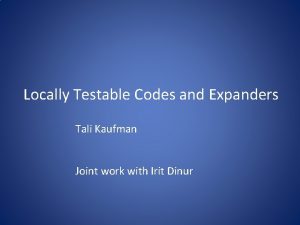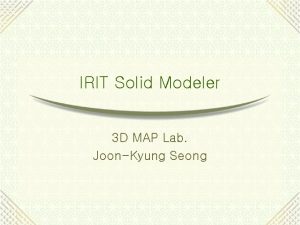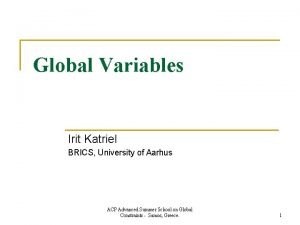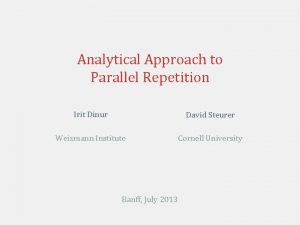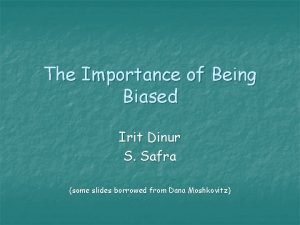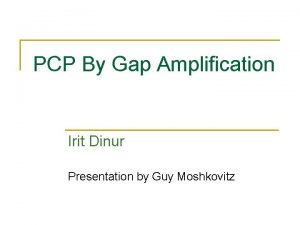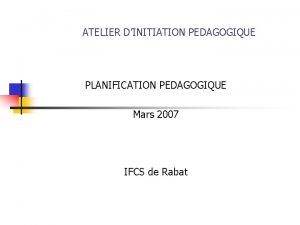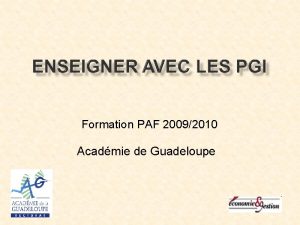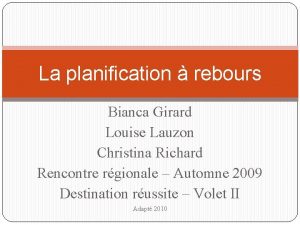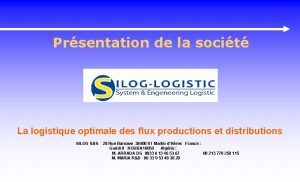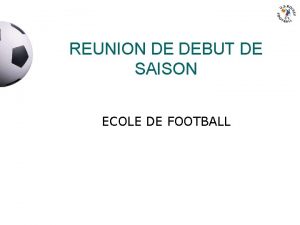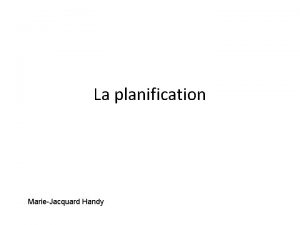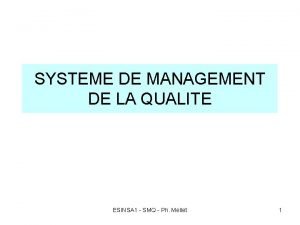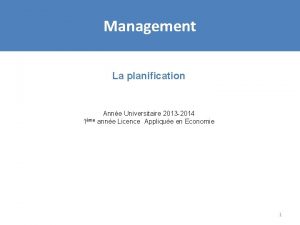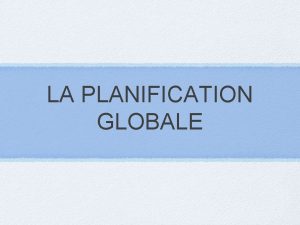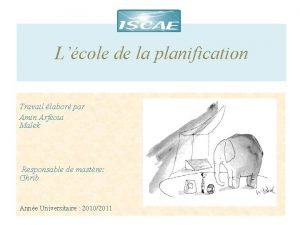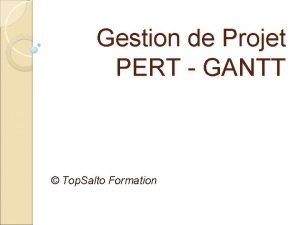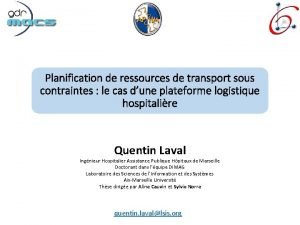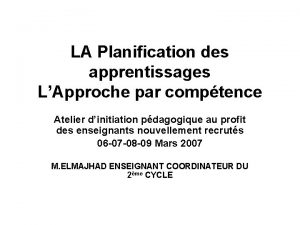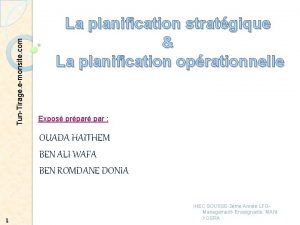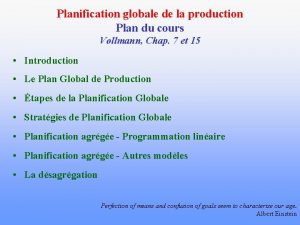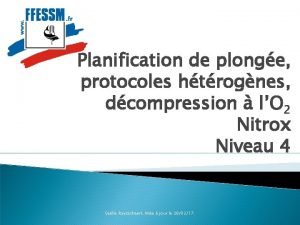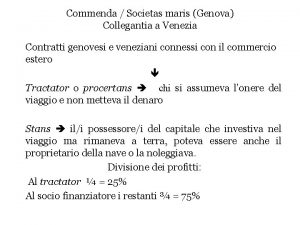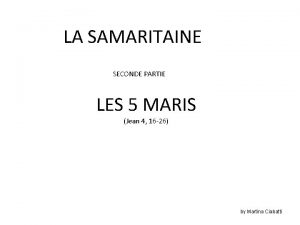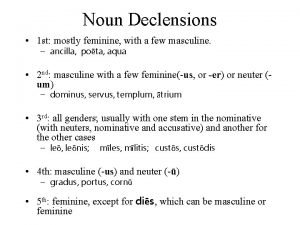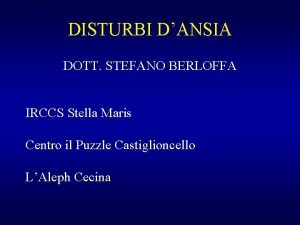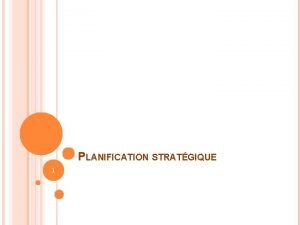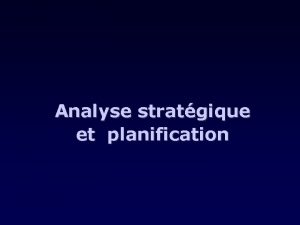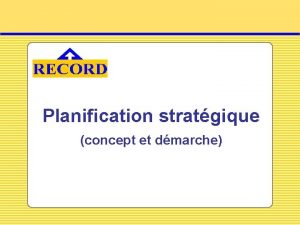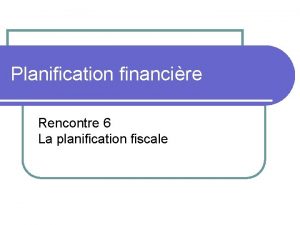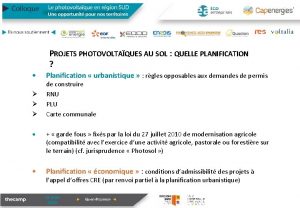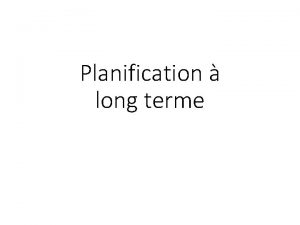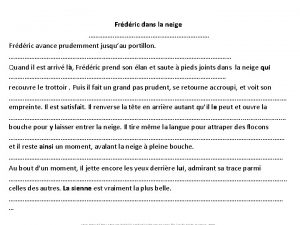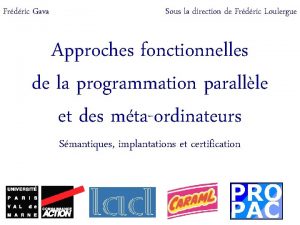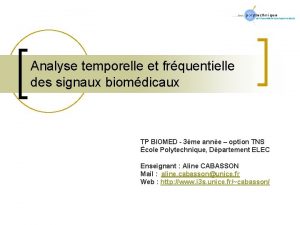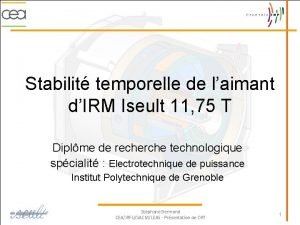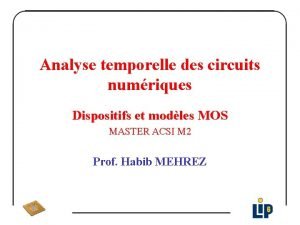Planification Temporelle Frdric MARIS Maris IRIT 2009 IRIT











![Historique • Les premiers planificateurs temporels – DEVISER [Vere, 1981] Logique temporelle basée sur Historique • Les premiers planificateurs temporels – DEVISER [Vere, 1981] Logique temporelle basée sur](https://slidetodoc.com/presentation_image_h2/f7620fcf91e85149a8d67741f7c5d8ac/image-12.jpg)




![Langage de représentation de TLP-GP p 1 p 3 p 2 A [durée] e Langage de représentation de TLP-GP p 1 p 3 p 2 A [durée] e](https://slidetodoc.com/presentation_image_h2/f7620fcf91e85149a8d67741f7c5d8ac/image-17.jpg)

![Exemple © Maris, IRIT 2009 A: +a[0; 5[ –a[5] +b[5] –d[5] B : a[0] Exemple © Maris, IRIT 2009 A: +a[0; 5[ –a[5] +b[5] –d[5] B : a[0]](https://slidetodoc.com/presentation_image_h2/f7620fcf91e85149a8d67741f7c5d8ac/image-19.jpg)
![Expansion du graphe de planification A : +a[0; 5[ –a[5] +b[5] –d[5] B : Expansion du graphe de planification A : +a[0; 5[ –a[5] +b[5] –d[5] B :](https://slidetodoc.com/presentation_image_h2/f7620fcf91e85149a8d67741f7c5d8ac/image-20.jpg)
![Extraction d’un plan-solution flottant (TLP-GP 1) B : a[0] +c[0; 4[ +d[4] –c[4] C Extraction d’un plan-solution flottant (TLP-GP 1) B : a[0] +c[0; 4[ +d[4] –c[4] C](https://slidetodoc.com/presentation_image_h2/f7620fcf91e85149a8d67741f7c5d8ac/image-21.jpg)

![Plan-solution flottant A 1[5] a b T I N a d L A O Plan-solution flottant A 1[5] a b T I N a d L A O](https://slidetodoc.com/presentation_image_h2/f7620fcf91e85149a8d67741f7c5d8ac/image-23.jpg)












![Plan-solution flottant A 1[5] a b T I N a d L A O Plan-solution flottant A 1[5] a b T I N a d L A O](https://slidetodoc.com/presentation_image_h2/f7620fcf91e85149a8d67741f7c5d8ac/image-36.jpg)






- Slides: 42

Planification Temporelle Frédéric MARIS © Maris, IRIT 2009 IRIT – Université Paul Sabatier – Toulouse 1

Plan • Introduction • Planification temporelle : le système TLP-GP © Maris, IRIT 2009 • Conclusion et perspectives 2

Planification • Faire une céramique… © Maris, IRIT 2009 Etat Initial Introduction I have a plan … ? But 3

Planification Plan 1. Mouler les céramiques 2. Allumer le four Etat Initial 1 3. Cuire les céramiques 4. Assembler les céramiques But © Maris, IRIT 2009 2 3 Introduction 4 4

Planification • Cadre classique de la planification : – Actions instantanées, discrètes, déterministes, – Monde totalement observable, pas d’incertitude. < Action > A p 1 < Préconditions > © Maris, IRIT 2009 p 2 Introduction e 1 e 2 < Effets > e 3 5

Planification : Définitions préliminaires • Etat : ensemble fini de formules atomiques (fluents). • Action : A = < Prec(A), Add(A), Del(A) >. © Maris, IRIT 2009 • Application de l’action A à un état E : E' = (E - Del(A)) Add(A). • Problème de planification : <A, I, G> où : – I ensemble fini de fluents, état initial du problème, – G ensemble fini de fluents, buts du problème. – A ensemble fini d’actions, Introduction 6

Algorithmes essentiels Recherche dans les espaces d’états GRAPHPLAN Recherche dans les espaces de plans partiels © Maris, IRIT 2009 Planification SAT (codage de la structure des plans possibles) Planification de type SATPLAN Introduction Planification de type BLACKBOX 7

© Maris, IRIT 2009 Planification temporelle : problématique Amélioration des solveurs SAT Très bons résultats de la planification SAT Amélioration des solveurs DTP et SMT Résultats pour la planification temporelle ? Planification temporelle 8

Planification temporelle : problématique PLAN Temps Mouler les céramiques Etat Initial 1 Cycle de chauffe du four Cuire les céramiques Assembler 2 © Maris, IRIT 2009 3 4 5 6 Planification temporelle But 9

Planification temporelle : problématique Etat Initial Cuire les pâtes But : Manger un plat de pâtes chaud (5 min. ) Cuire les lardons © Maris, IRIT 2009 Concurrence des actions obligatoire Casser l’oeuf Préparer la carbonara Planification temporelle 10

Planification temporelle : problématique qui ne nécessitent pas la concurrence des actions Temporellement Simples Problèmes de planification temporels © Maris, IRIT 2009 qui nécessitent la concurrence des actions Temporellement Expressifs Planification temporelle 11
![Historique Les premiers planificateurs temporels DEVISER Vere 1981 Logique temporelle basée sur Historique • Les premiers planificateurs temporels – DEVISER [Vere, 1981] Logique temporelle basée sur](https://slidetodoc.com/presentation_image_h2/f7620fcf91e85149a8d67741f7c5d8ac/image-12.jpg)
Historique • Les premiers planificateurs temporels – DEVISER [Vere, 1981] Logique temporelle basée sur les instants © Maris, IRIT 2009 FORBIN [Dean, Firby, Miller, 1988] Ix. Te. T [Ghallab, Alaoui, 1989. a/b] [Alaoui, 1990] TRIPTIC [Rutten, Hertzberg, 1993] TEST [Reichgelt, Shadbolt, 1990]… Logique temporelle basée sur les intervalles TIMELOGIC [Allen, Koomen, 83] TLP [Tsang, 87] … algorithmes de recherche dans des espaces de plans Planification temporelle 12

Algorithmique • Recherche dans les espaces d’états étendus – Planification DEP – Planification à progression temporelle flottante • Recherche dans les espaces de plans partiels – Satisfaction de contraintes temporelles simples (STN/STP) – Satisfaction de contraintes temporelles disjonctives (DTP) • GRAPHPLAN temporel © Maris, IRIT 2009 – Construction du graphe guidée par le temps – Construction du graphe guidée par les actions Planification temporelle 13

Taxinomie Espaces d'états étendus © Maris, IRIT 2009 Espaces de plans partiels Planification temporelle Extensions temporelles de GRAPHPLAN 14

Introduction • Cadre temporel (PDDL 2. 1) : – – Actions avec durée (duration), Préconditions at start, at end, over all, Effets at start, at end, Evènements exogènes et buts temporellement étendus, p 1 p 3 p 2 © Maris, IRIT 2009 A [durée] e 1 Planification temporelle e 2 15

Introduction • Compétitions IPC : – Les planificateurs les plus efficaces ne sont pas temporellement expressifs, – Les benchmarks des IPC ne sont pas temporellement expressifs, © Maris, IRIT 2009 • Un petit nombre de planificateurs sont temporellement expressifs (VHPOP, LPGP, CRIKEY, Ix. Te. T, HSTN), • L’expressivité temporelle est restreinte à PDDL 2. 1. Planification temporelle 16
![Langage de représentation de TLPGP p 1 p 3 p 2 A durée e Langage de représentation de TLP-GP p 1 p 3 p 2 A [durée] e](https://slidetodoc.com/presentation_image_h2/f7620fcf91e85149a8d67741f7c5d8ac/image-17.jpg)
Langage de représentation de TLP-GP p 1 p 3 p 2 A [durée] e 1 e 3 e 2 • (over [(+ start 2) end[ (ready ? k)) © Maris, IRIT 2009 • (somewhere [start (+ start 2)] (ready ? k)) • (minimal-duration 5 anywhere [30 40] (baked p 3)) Planification temporelle 17

Principes de TLP-GP • Expansion d’un graphe de planification simplifié ; © Maris, IRIT 2009 • Extraction d’un plan-solution : GRAPHPLAN TLP-GP 1 Recherche arrière conditionnée par la satisfiabilité d’un DTP Planification SAT de type BLACKBOX TLP-GP 2 Codage du graphe en SMT, résolution, décodage Planification temporelle 18
![Exemple Maris IRIT 2009 A a0 5 a5 b5 d5 B a0 Exemple © Maris, IRIT 2009 A: +a[0; 5[ –a[5] +b[5] –d[5] B : a[0]](https://slidetodoc.com/presentation_image_h2/f7620fcf91e85149a8d67741f7c5d8ac/image-19.jpg)
Exemple © Maris, IRIT 2009 A: +a[0; 5[ –a[5] +b[5] –d[5] B : a[0] +c[0; 4[ +d[4] –c[4] C : c[0] –b[1] +e[1] Planification temporelle 19
![Expansion du graphe de planification A a0 5 a5 b5 d5 B Expansion du graphe de planification A : +a[0; 5[ –a[5] +b[5] –d[5] B :](https://slidetodoc.com/presentation_image_h2/f7620fcf91e85149a8d67741f7c5d8ac/image-20.jpg)
Expansion du graphe de planification A : +a[0; 5[ –a[5] +b[5] –d[5] B : a[0] +c[0; 4[ +d[4] –c[4] C : c[0] –b[1] +e[1] [5] a [0; 5[ a A A [5] b d a [0; 5[ a A [5] b d [4] c [0; 4[ c B [4] [5] bb d [4] c [0; 4[ c [5] [0] © Maris, IRIT 2009 [5] a [0; 5[ a [5] [0] B [4] d [1] [0] Niveau 1 Planification temporelle Niveau 2 C [1] Niveau 3 dd b ee 20
![Extraction dun plansolution flottant TLPGP 1 B a0 c0 4 d4 c4 C Extraction d’un plan-solution flottant (TLP-GP 1) B : a[0] +c[0; 4[ +d[4] –c[4] C](https://slidetodoc.com/presentation_image_h2/f7620fcf91e85149a8d67741f7c5d8ac/image-21.jpg)
Extraction d’un plan-solution flottant (TLP-GP 1) B : a[0] +c[0; 4[ +d[4] –c[4] C : c[0] –b[1] +e[1] Contraintes A : +a[0; 5[ –a[5] +b[5] –d[5] A b d s(A 1)+5 s(B 2)+4 s(A 1) s(B 2) s(A 1)+5< s(B 2)+4 s(B 2)< s(A 1)+5 s(C 3)+1< s(A 1)+5 [5] a [0; 5[ a A [5] b d [4] c [0; 4[ c B [4] [5] b d [4] c [0; 4[ c [5] [0] © Maris, IRIT 2009 s(C 3)< s(B 2)+4 a [0; 5[ a [5] s(A 1)+5 s(C 3)+1 [5] a [0; 5[ a A s(B 2) s(C 3) [0] a b b c [4] d C [ s(A 1); s(B 2)] [ s(A 1); s(A 1)+5[ [ s(A 1)+5] [ s(A 1)+5; G] [ s(C 3)+1] [ s(B 2); s(C 3)] [ s(B 2); s(B 2)+4[ c [ s(B 2)+4] d [ s(B 2)+4] [ s(B 2)+4; G] B [1] Niveau 2 a [5] [0] Niveau 1 Planification temporelle Agenda [1] Niveau 3 d b e d e [ s(A 1)+5] [ s(C 3)+1; G] 21

Extraction d’un plan-solution flottant (TLP-GP 1) • Actions du plan flottant : { A 1, B 2, C 3 } • Contraintes temporelles : s(A 1) s(B 2) s(A 1)+5 < s(B 2)+4 s(B 2) < s(A 1)+5 s(B 2) s(C 3)+1 < s(A 1)+5 s(C 3) < s(B 2)+4 • Instants caractéristiques ordonnés : s(A 1) s(B 2) s(C 3) < s(C 3)+1 < s(A 1)+5 < s(B 2)+4 © Maris, IRIT 2009 (Il existe d’autres ordonnancements possibles) Planification temporelle 22
![Plansolution flottant A 15 a b T I N a d L A O Plan-solution flottant A 1[5] a b T I N a d L A O](https://slidetodoc.com/presentation_image_h2/f7620fcf91e85149a8d67741f7c5d8ac/image-23.jpg)
Plan-solution flottant A 1[5] a b T I N a d L A O a I G B 2[4] c c d c C 3[1] © Maris, IRIT 2009 b e I s(A 1) s(C 3) s(B 2) s(A 1)+5 s(C 3)+1 G s(B 2)+4 5 < Temps d’exécution < 8 Planification temporelle 23

Extraction d’un plan-solution flottant (TLP-GP 2) • Codage © Maris, IRIT 2009 – Règle 1: Etat initial et But n. Init Planification temporelle n. Goal 24

Extraction d’un plan-solution flottant (TLP-GP 2) • Codage © Maris, IRIT 2009 – Règle 2: Production des préconditions par liens causaux nb Planification temporelle 25

Extraction d’un plan-solution flottant (TLP-GP 2) • Codage © Maris, IRIT 2009 – Règle 2: Production des préconditions par liens causaux na Planification temporelle p nb 26

Extraction d’un plan-solution flottant (TLP-GP 2) • Codage © Maris, IRIT 2009 – Règle 3: Activation des actions et ordre partiel na Planification temporelle p nb 27

Extraction d’un plan-solution flottant (TLP-GP 2) • Codage © Maris, IRIT 2009 – Règle 3: Activation des actions et ordre partiel p na (na→ p) [… Planification temporelle nb (p→ nb) [… 28

Extraction d’un plan-solution flottant (TLP-GP 2) • Codage © Maris, IRIT 2009 – Règle 4. 1: Exclusions mutuelles temporellement étendues nc Planification temporelle na p nb 29

Extraction d’un plan-solution flottant (TLP-GP 2) • Codage © Maris, IRIT 2009 – Règle 4. 1: Exclusions mutuelles temporellement étendues nc p na (nc→ p) …] Planification temporelle nb (na→ p) [… 30

Extraction d’un plan-solution flottant (TLP-GP 2) • Codage © Maris, IRIT 2009 – Règle 4. 1: Exclusions mutuelles temporellement étendues nc p na (nc→ p) …] Planification temporelle (na→ p) [… nb (p→ nb) …] nc (nc→ p) [… 31

Extraction d’un plan-solution flottant (TLP-GP 2) • Codage © Maris, IRIT 2009 – Règle 4. 2: Exclusions mutuelles temporellement étendues nb Planification temporelle na 32

Extraction d’un plan-solution flottant (TLP-GP 2) • Codage © Maris, IRIT 2009 – Règle 4. 2: Exclusions mutuelles temporellement étendues nb na (nb→ p) (na→ p) …] [… Planification temporelle 33

Extraction d’un plan-solution flottant (TLP-GP 2) • Codage © Maris, IRIT 2009 – Règle 4. 2: Exclusions mutuelles temporellement étendues nb na (nb→ p) (na→ p) …] [… Planification temporelle na nb (na→ p) (nb→ p) …] [… 34

Extraction d’un plan-solution flottant (TLP-GP 2) • Codage © Maris, IRIT 2009 – Regle 5: Bornes inférieure et supérieure Planification temporelle 35
![Plansolution flottant A 15 a b T I N a d L A O Plan-solution flottant A 1[5] a b T I N a d L A O](https://slidetodoc.com/presentation_image_h2/f7620fcf91e85149a8d67741f7c5d8ac/image-36.jpg)
Plan-solution flottant A 1[5] a b T I N a d L A O a I G B 2[4] c c d c C 3[1] © Maris, IRIT 2009 b e I s(A 1) s(C 3) s(B 2) s(A 1)+5 s(C 3)+1 G s(B 2)+4 5 < Temps d’exécution < 8 Planification temporelle 36

Résultats expérimentaux • Nouveaux benchmarks (http: //tlpgp. free. fr/) – Extensions de l’exemple – Cooking (pâtes à la carbonara) © Maris, IRIT 2009 – Temporal-machine-shop (cuisson de céramiques) Planification temporelle 37

© Maris, IRIT 2009 Résultats expérimentaux Planification temporelle 38

© Maris, IRIT 2009 Résultats expérimentaux Planification temporelle 39

© Maris, IRIT 2009 Résultats expérimentaux Planification temporelle 40

© Maris, IRIT 2009 Interface graphique de TLP-GP 1 Planification temporelle 41

© Maris, IRIT 2009 Conclusion et perspectives 42
 Planification temporelle
Planification temporelle Contiguité temporelle
Contiguité temporelle Ttanos
Ttanos Sommation temporelle muscle
Sommation temporelle muscle Tali kaufman
Tali kaufman Irit katriel
Irit katriel Irit katriel
Irit katriel Irit dinur
Irit dinur Irit katriel
Irit katriel Irit katriel
Irit katriel Planification pédagogique
Planification pédagogique Mésocycles
Mésocycles Planification de la production
Planification de la production Planification à rebours
Planification à rebours Planification structurelle et opérationnelle
Planification structurelle et opérationnelle Silogsas
Silogsas Programmation annuelle école de football
Programmation annuelle école de football Counseling en planification familiale
Counseling en planification familiale Planification journalière enseignant
Planification journalière enseignant Planification stratégique
Planification stratégique Planification opérationnelle
Planification opérationnelle Planification formelle
Planification formelle Planification pouponnière
Planification pouponnière Planification globale
Planification globale Le counseling en planification familiale
Le counseling en planification familiale Planification stratégique
Planification stratégique Reseau pert
Reseau pert Planification du marketing
Planification du marketing Planification sous contrainte
Planification sous contrainte La planification des apprentissages
La planification des apprentissages Planification opérationnelle
Planification opérationnelle التخطيط الاجمالي للانتاج
التخطيط الاجمالي للانتاج Le narval
Le narval Planification de la demande
Planification de la demande Maris vilms
Maris vilms Maris hall
Maris hall Societas maris
Societas maris Robori latino
Robori latino Ivana dulic maris li
Ivana dulic maris li Les cinq maris de la samaritaine
Les cinq maris de la samaritaine Civis declension
Civis declension Māris āboliņš
Māris āboliņš Stefano berloffa stella maris
Stefano berloffa stella maris
